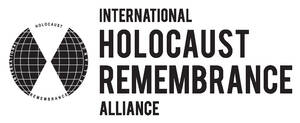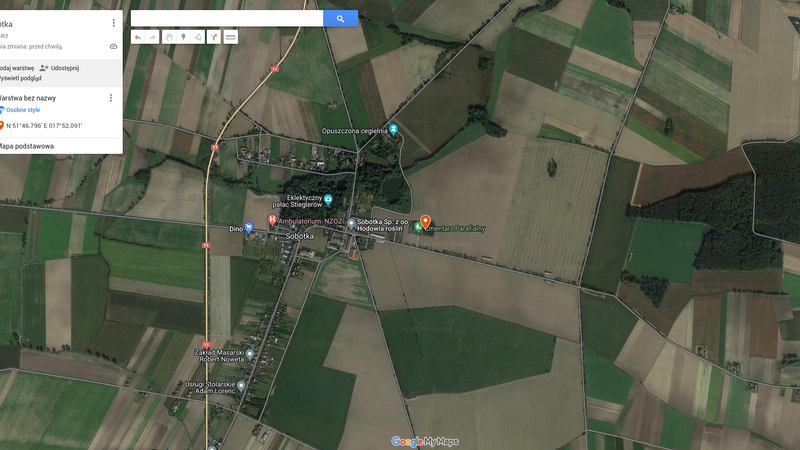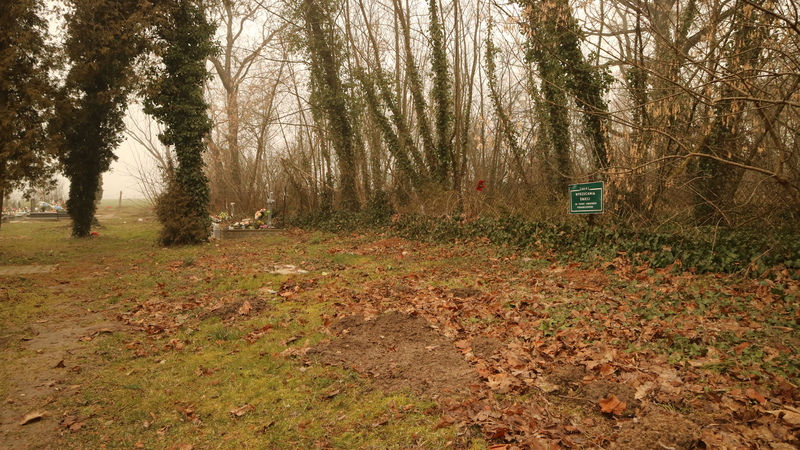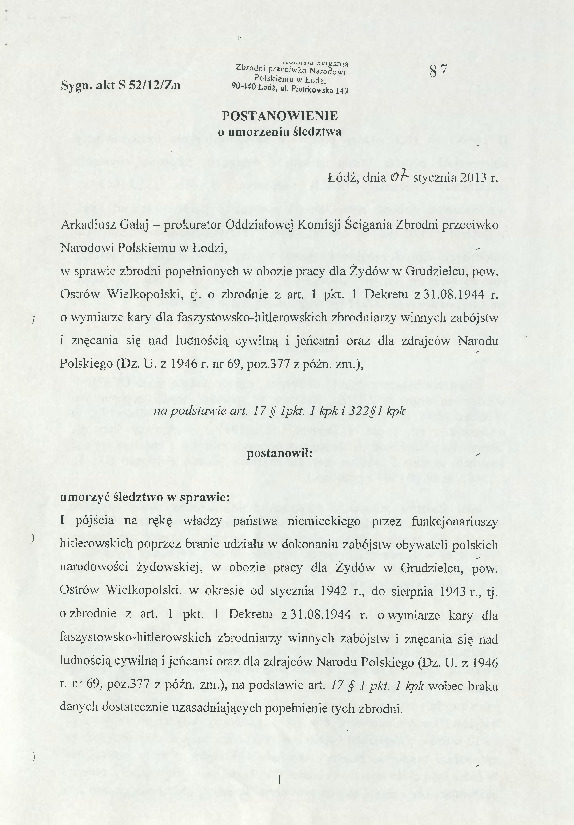Sobótka
Borough of Ostórw Wielkopolski , Ostrowski District, Wielkopolskie VoivodshipType of place
Parish cemetery in SobótkaInformation about the crime
On March 23, 2023, we went to Sobótka to meet a representative of the Wielkopolska Provincial Office and to carry out a site inspection of the burial place of dozens of Jews, victims of the Grudzielec labor camp. The alleged burial site is located along the eastern fence in the Sobótka parish cemetery. There were no other graves at the site after the war.
German crimes committed against Jews in the Grudzielec labor camp were the subject of an investigation conducted by the Regional Commission for the Examination of Crimes against the Polish Nation, which was discontinued in 2013. The investigation established that:
“The forced labor camp for Jews (Arbeitsjudenlager) in Grudzielec (Gruden in German) was established in January 1942. It was located in an old devastated manor house of the former estate of Zygmunt Zielewicz, where the Jews were placed in several rooms, unheated and mostly without panes. The camp was intended for men of Jewish nationality. Most of the prisoners were brought to Grudzielec from the ghetto in Łódź. At the beginning of 1942, Jewish prisoners from a similar forced labor camp in Grudzielec Nowy, where they had been employed since late 1941, were also brought to the camp. […] The prisoners in the camp were employed on the estate and in the construction of the road leading from Grudzielec to Grudzielec Nowy and Bieganin, then in the construction of the road to Sobótka. They worked regardless of the weather conditions. In winter, they walked barefoot or in clogs, often wading up to their knees in snow. Sanitary conditions were scandalous. Prisoners slept on straw scattered on the floor. There was a shortage of doctors, and prisoners were suffering from hunger and lice. […] On February 11, 1942, in Sobótka, there was a public execution of Dawid Goldberg, an inmate of the labor camp for Jews from Grudzielec Stary. […] The camp in Grudzielec was liquidated in 1943. The Jews who survived were probably deported to the wrześnieński district or Nakło nad Notecią.
The following witnesses were interviewed during the investigation:
“Waclaw Klupś testified that he had lived in Grudzielec since 1910. His apartment was located near the camp of the Jews. He worked near the camp, as he was employed at the estate where the Jews lived. The estate had a complex of buildings. One was completely ruined, with no glass in the windows. The Germans placed the Jews in this brick building. […] He reported that the camp operated for years and was liquidated in 1943. He did not know what happened to the Jews after the camp was liquidated. The camp was for Jewish men only. […] He testified that he was seen by Kaczmarek [one of the guards] beating one of the Jews on the head and back with a cane stick. He later learned from other camp residents that the Jew had died. He added that he was aware of three cases of Jews dying of exhaustion and beatings. The bodies were taken to the Catholic cemetery in Sobótka. According to Klupś, the camp was able to accommodate 40 prisoners. […] He heard that in Sobótka, the neighboring village, Jews from the Grudzielec camp were working on road construction. One of them, kicked by a German during work, swung at him with a shovel. He did not hit the German, as he was held down, but was beaten and did not return to the camp. After some time, he was brought to Sobótka and publicly hanged there.
Andrzej Kociemba […] heard that one Jew from the camp in Grudzielec was hanged in Sobótka for having swung a shovel at a German who was the mayor of Biniewo. He heard that 12 people reportedly died [in the camp].
Boleslaw Jasiński […] indicated that the camp was established in August or September 1941 and was liquidated in late 1943 or early 1944. He heard that the Jews in the camp came from Kalisz and Łódź.
Wladyslaw Kaczor testified that he was a resident of Grudzielec. According to his observations, about ten people died in the camp. He added that he made coffins for the first six bodies in the workshop. He did not make any more coffins, but he saw the corpses being wrapped in paper and later in a blanket. According to him, about 100-120 people were in the camp. To his knowledge, the camp was established in the fall of 1941 and liquidated after a year and a half.
Kazimierz Kaczmarek testified that there were at most 80 people in the camp. […] According to him, during the period of the camp’s existence, 4 or 5 people died there. […]
He heard that Commissioner Steinberg hit one of the Jews with a bullwhip while he was working. The Jew swept at the commissioner with a shovel but did not hit him. Nevertheless, Steinberg took out a revolver and fired two shots into the air. After some time, German police from Sobótka arrived and took the Jew away, probably to Łódź. About a month after this incident, the Jew was executed in front of the Sobótka church. The execution and the incident with Steinberg were recounted to him by the Jew Icek Berkenstadt.
Ludwik Grajaszek testified that around March 1940, the Germans organized a camp for Jews in Grudzielec. […] There were about 80-90 prisoners in the camp. […] The Jews in the camp were mostly from Działoszyn and Cielczagłowa in the vicinity of Częstochowa. They were placed in the camp because of their origin and the need for a workforce in the Grudzielec and Sobótka area. […] He only heard from stories that one of the Jews from the camp was hanged. […] He was reportedly brought to the execution massacred and half alive.
[…] The investigation established that the person hanged in Sobótka was Dawid Goldberg. The death certificate drawn up for him stated that he died on February 11, 1942, in Grudzielec in a Jewish labor camp”.
Meanwhile, a letter from the Presidium of the Gromadzka National Council dated July 18, 1970, addressed to the District Prosecutor’s Office in Ostrów Wielkopolski, states that the man hanged in February 1942 in Sobótka was Jakob Filcman. Perhaps these are entirely different events, although they would have been separated by only six days: “One of the Jewish prisoners, who was in the camp in Grudzielec, was publicly hanged by the Gestapo. The execution was carried out on the gallows built in the cemetery by the Roman Catholic parish church in Sobótka in the midday hours of February 17, 1942. The hanged man was Filcman Jakob, a Jew, born June 30, 1911 in łódź, parents: Josek Boruch and Ruchla, née Zelmanowicz. This event is registered in the death book of 1942 in the local registry office, file number 9.
Other deaths are registered in the same book, such as:
The book of deaths of the year 1942, no. 2, lists a Jew, Szyja Bekrman, resident of Łódź, born on December 29, 1913, in Łódź, son of Grzenger and Maria née Epsztajn. He died on January 5, 1942, in Grudzieniec-Arbeitsjudenlager.
The same book, No. 3, lists the death of a Jewish man, Lejb Krakowski, resident of Łódź, born on February 16, 1913, in Łódź, son of Zalin and Chudes, née Spiro. He died on January 15, 1942.
No. 12 lists the death of a Jewish man, Szlama Małogold, resident of the ghetto in Łódź, born July 19, 1900, in Łódź, son of Dawid and Brandla née Gerszonowicz. Died on February 2, 1942 in Grudzieniec-Arbeitsjudenlager.
No. 15 lists the death of a Jewish man, Dawid Goldberg, resident of the ghetto in Łódź, born on July 3, 19023, in Łódź, son of Choja and Rywka Goldberg. He died on February 11, 1942, in Grudzieniec-Arbeitsjudenlager.
No. 24 lists the death of a Jewish man, Abraham Wołkowicz, resident of the ghetto in Łódź, born on September 8, 1920. There is no information about his parents. He died on January 5, 1942, in Grudzieniec-Arbeitsjudenlager.
No. 25 lists the death of a Jewish man, Dawid Mandelbaum, a resident of the ghetto in Łódź, born on December 28, 1896; there is no information about his parents. He died on January 13, 1942, in Grudzieniec-Arbeitsjudenlager.
No. 26 lists the death of a Jewish man – Riwen Zwierzyniecki, from the ghetto in Łódź. He was born on June 22, 1889. He died on February 5, 1942, in Grudzieniec-Arbeitsjudenlager; there is no information about his parents.
No. 27 lists the death of a Jewish man – Hirsch Wigdor Majerowicz, from the ghetto in Łódź. He was born on May 16, 1916. Died on February 28, 1942 in Grudzieniec-Arbeitsjudenlager. There is no information about his parents.
No. 36 lists the death of a Jewish man, Jakob Berkowicz, from the ghetto in Łódź. He was born on January 10, 1895. Died on February 13, 1942 in Grudzielec-Arbeitsjudenlager. There is no information about his parents.
No. 37 lists the death of a Jewish man, Hersch Brodziak, from the ghetto in Łódź. He was born on November 9, 1924. He died on February 19, 1942, in Grudzieniec-Arbeitsjudenlager. There is no information about his parents.
No. 74 lists the death of a Jewish man, Herschlik Grun from Działoszyn, born on December 14, 1896. He died on March 12, 1942, in Sobótka-Judenarbeitslager.
No. 75 lists the death of a Jewish man, Moschek Herschlikowicz, born on July 18, 1927, resident of Kellerbach. He died on March 26, 1942, in Sobótka-Judenarbeitslager.
According to the stories of local residents, many more Jewish prisoners died than were registered in the death records of the registry office. It is believed that about 30 of them died and were buried in the Roman Catholic burial cemetery in Sobótka”.
IDENTIFICATION OF THE GRAVE BASED ON NON INVASIVE RESEARCH
On March 2, 2023, an on-site inspection was carried out at the parish cemetery in Sobótka. During the inspection of the area, an area was identified in the eastern part of the cemetery (GPS: N51°46.796′ E 017°52.091′), which is probably the burial place of several dozen victims of the Grudzielec camp. The area free from visible, modern tombstones has approximate dimensions of approx. 10.0-13.0 m x 3.50 m.
Landform measurement (LiDAR) is not helpful in this case.
No search was conducted for archival aerial photographs for this area.
Sources
Contact and cooperation
We are still looking for information on the identity of the victims and the location of Jewish graves in Sobótka. If you know something more, write to us at the following address: fundacjazapomniane@gmail.com.
Bibliography
Decision of January 7, 2013 on discontinuance of the investigation into crimes committed in the labor camp for Jews in Grudzielec, Ostrów Wielkopolski district (file no. S 52 /12/Zn)
Official note to the investigation of The Regional Commission for the Examination of Crimes against the Polish Nation in Łódź, file no. S 52/12/Zn on crimes committed at the labor camp for Jews in Grudzielec, Ostrów Wielkopolski district (Łódź, August 10, 2012)
Letter from the Presidium of the Gromadzka National Council, dated July 18, 1970, addressed to the District Prosecutor’s Office in Ostrów Wielkopolski.
Copy of an undated letter from Jan Kaczmarek to the Polish Institute of National Remembrance Branch in Poznań (Jan Kaczmarek’s address and telephone number require anonymization)
Official note to the investigation of the Branch Commission for The Regional Commission for the Examination of Crimes against the Polish Nation in Łódź, file no. 52/12/Zn regarding crimes committed in the labor camp for Jews in Grudzielec, Ostrów Wielkopolski district (Łódź, September 20, 2012)
“A mass grave in the Sobótka cemetery of the murdered Jews in 1942-1943”
We have collected the materials about this village thanks to the funding provided by the International Holocaust Remembrance Alliance as part of the project “The rural Holocaust. Collecting and safeguarding the never recorded testimonies 100 forgotten Jewish graves 2021-2022”.

 sobótka fotografia satelitarna 1a
sobótka fotografia satelitarna 1a sobótka fotografia 2 lokalizacji
sobótka fotografia 2 lokalizacji Postanowienie o umorzeniu śledztwa. Sobótka
Postanowienie o umorzeniu śledztwa. Sobótka